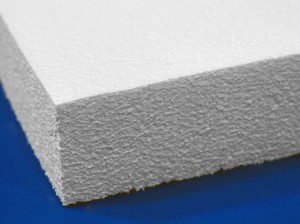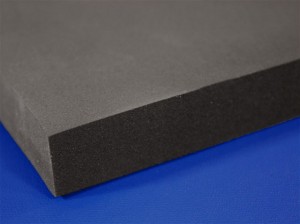Foam, in all of its varieties, is a material that is most often used to get a job done. Whether insulating a home, padding a couch cushion, or treating reflection points as acoustical treatment, foam puts in long hours on the job, helping us perform better in ours.
But while foam is valuable from nine-to-five, it also can be used recreationally in ways that help us better enjoy our free time. One of foam’s best uses is as a hobby medium, making modeling, scene building, and remote controlled racing more enjoyable.

As a toy almost everybody has had at some point in their lives, foam airplane gliders hold a soft spot in the hearts of many. But while the experience ends for most of us with the punch-out foam glider kits you can construct in seconds, others take their love of flying further, creating their own custom planes that are measured in feet and not inches, able to travel hundreds of feet in a single flight.
The material used to make these impressive attempts at aviation is usually polystyrene. This is a closed-cell foam, most often seen as white foam coffee cups or protective packaging. Polystyrene possesses two traits that allow it to excel as a foam glider medium. The most obvious is the weight of the material, which allows it to glide through the air smoothly. Most polystyrene foam used for gliders is one or two pound density, which means in a 12 inch by 12 inch by 12 inch cubic block, the cube would only be one or two pounds. Despite that minimal weight, polystyrene remains rigid and strong, maintaining the form needed to glide.
Polystyrene’s other helpful craft foam characteristic is its moldability. This foam is unique among materials in that it isn’t able to be cleanly cut with straight or serrated blades. This may sound like a problem, but hot wire cutting tools are made just for polystyrene, giving users the ability to make cuts with much more detail than is possible with traditional instruments. These tools let curves and contours be made for the fuselage and wings that would be impossible to create with cutting tools that don’t pass through the material as smoothly as the hotwire cutter. Foam Factory stocks 1LB, 2LB, and 3LB density polystyrene sheeting in various thicknesses, but only suggests 1LB and 2LB densities for glider hobbyists. 2LB offers greater durability than 1LB, but for beginners and concept designs, 1LB is more cost-effective.
Another hobby which utilizes polystyrene is model railroading. The extent of some setups may only be a ring around the Christmas tree during the holidays, but railroading enthusiasts often have complete, miniature sprawling towns taking up entire rooms in their homes. Part of the fun of model railroading is creating your own little world, and for landscaping mountains, valleys, and hills, polystyrene provides the perfect modeling material. These hobby foam forms can be created from sheets glued together and cut with traditional serrated blades. You won’t get the flawless edges of a hotwire cutter, but sealing the foam with drywall joint compound will give you smooth surfaces which are also able to be painted. Using this strategy, you can paint foam and create whole mountain ranges that are completely customized and shockingly light.
Another hobby that can benefit from the use of foam is slot car racing. For setups where the race track rests within a setting, polystyrene can again be used as landscaping, just like with railroading. But for performance racing, another style of foam can benefit slot car hobbyists.
In performance-focused setups, curves and bends in a track can cause cars to fishtail or power slide, mimicking real life performance and enhancing the experience. The problem however, is most tracks do not accommodate the extra space this sideways movement requires. Some tracks have railings around the edge, but these give an advantage to the outside track while racing, since the person in that lane can take the turn faster by leaning on the rail. Conversely, removing the railings means the outside lane can go off the track and de-slot, giving the advantage to the person on the inside. The solution to this is extending a track’s width with a racing border using thin, closed-cell foam sheets.

Depending on the scale of the setup, hobbyists can add neoprene or cross-linked polyethylene (XLPE) foam to the bends in a track, both of which Foam Factory carries. These closed-cell foams are desirable because of both the appearance and performance they offer. Made in dark charcoal colors, these foams blend in with most tracks while rigidity of the material is also a benefit, as it won’t hurt the performance of the vehicle.
For permanent setups, hobbyists cut strips and flex them flush around the track and either glue or tack down the material. Those who require more sliding space sometime create tiles that butt up to the track and may even lock into the existing track with minor modifications. Neoprene and XLPE can both be cut smoothly with a sharp, non-serrated blade, and are also able to be sanded down for perfect fits along the raceway.
These are only a few examples of the way foam can used for a little fun. Of course, the only limitation is creativity, so if you’ve found a great way to enjoy your hobbies and free time with foam, we’d love to hear how!
NOTE: We do not suggest using hotwire cutters on polystyrene forms that have been glued together from multiple sheets. If a design requires multiple pieces of foam be bonded to create a glider, cut the sheets individually then glue them together and gently sand with fine-grit sandpaper.

